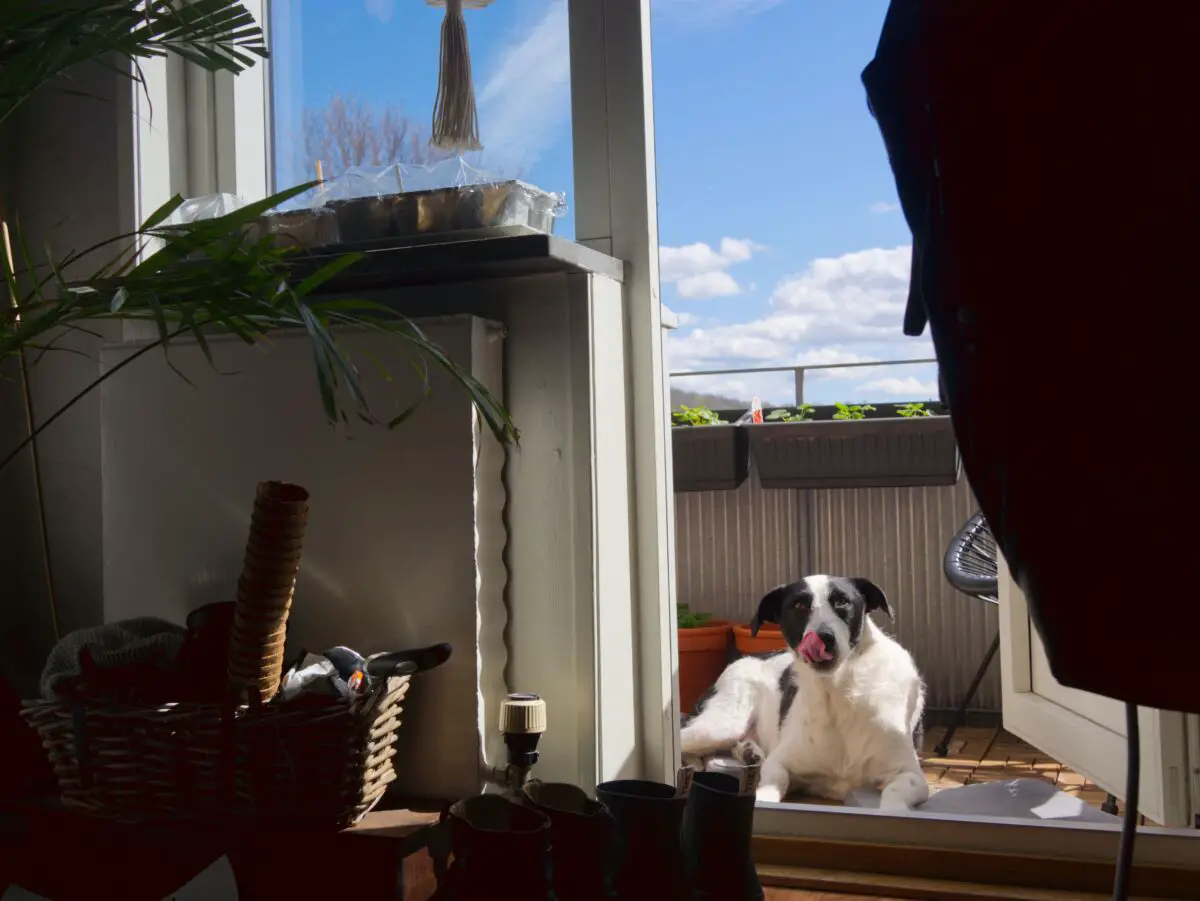Most likely, your dog gets pretty excited when he gets out on the balcony after staying all day indoors. For people living in high-density areas, the balcony offers a great opportunity to give their dogs a bit of fresh air. However, you must consider your dog’s safety.
Balconies may not be safe for dogs if you leave them unsupervised. The dog may be affected by extreme weather conditions or take a dangerous leap to the ground to chase a cat or squirrel. Some balcony plants might also be poisonous to dogs.
Find out how exactly these issues affect your dog so you can prevent them.
Extreme Weather Conditions on Balconies
If left unattended on a balcony, dogs may experience extreme heat or cold. This is such a major concern that a group of dog lovers once signed a petition in 2016 to limit the duration that Toronto dog owners can leave their pets unattended on balconies.
Extreme weather can seriously harm your lovely pet, even if you’re just leaving your dog on the balcony for a few hours.
Your area may have sub-zero temperatures which won’t take long to cause serious health conditions like:
- sick or elderly dogs having difficulty in regulating body temperature
- increased joint stiffness and discomfort
- frostbite
- altered metabolism
Various jurisdictions have even implemented regulations regarding this issue. For instance, Prince George’s County, Maryland, in conjunction with the Humane Society of Prince George’s County (PGSPCA), adopted the minimum standards for enforcement of anti-cruelty law. Based on the law, pet owners should not allow or maintain dogs or cats on balconies without accompanying the pet.
Heat is just as harmful as extreme cold.
Even if your balcony is covered, it can get hot quite fast as the sun beats down on it.
Your dog may experience heatstroke, with such symptoms as glazed eyes, heavy panting, rapid heartbeat, excessive thirst, difficulty breathing, lethargy, dizziness, fever, lack of coordination, vomiting, profuse salivation, deep red/ purple tongue, seizure, and even unconsciousness.
Even mild weather conditions may pose a threat to your dog if he has certain conditions that make him more susceptible to harm, for example:
- too young
- too old
- not conditioned to prolonged exercise
- overweight
- having heart or respiratory disease
You should also consider the particular dog breed, since some breeds may face difficulty breathing in extreme heat. Such dogs include pugs, boxers, Shih Tzus, or any other dogs with short muzzles.

Will My Dog Jump off the Balcony?
Perhaps you assume that you’ve trained your dog well enough to stay calm on your balcony. But you cannot predict what your dog may do in case something intriguing grabs his attention.
Your dog would not be getting much mental stimulation from just staying on the balcony. This can make him get really frustrated when seeing people, other dogs, or any action on the ground.
At that point, the dog may jump over your balcony railing and get hurt.
This is such a common occurrence that it’s been given the name high-rise syndrome. It’s the phenomenon of dogs or cats falling from high places.
Your dog may go through the railings, if they’re wide enough, or jump over it. That can lead to severe injuries, especially if the balcony is quite high.
How high can a dog jump, and can it easily jump over the railing?
The height your dog can jump will depend on the dog’s breed and health. Some dogs can jump up to 6 feet (1.8 meters), and others may only manage a few inches.
The height your dog can jump is an important consideration when assessing the height of your balcony railing. According to the International Residential Code, balcony railings should be 36 inches (91 centimeters) high for residential houses. It’s slightly higher for business premises or fencing use: 42 or 48 inches (107 or 122 centimeters).
As you can see, some dogs may easily jump over the normal balcony railing in your home.
However, different communities have different height requirements for balcony railings.
But your dog may not need to jump the railing with one leap. If there are objects nearby, the dog can scramble and climb to get over the railing.
When they do fall off the balcony, dogs tend to suffer more than cats. The injuries could be fatal.
Poisonous Plants on the Balcony
If you let your dog onto the balcony, you must ensure your pot plants aren’t toxic.
You can confirm whether your pot plants are safe by referring to information provided by The American Society for the Prevention of Cruelty to Animals (ASPCA). Here are some of the listed plants that can harm your dog:
- tulips
- lilies
- azaleas
- sago palm
- peonies
- iris
- branching and California ivy
- Chinese evergreen
You can replace those plants with other non-toxic alternatives. Various non-toxic options include:
- African daisy
- African violet
- sprouts
- baby’s breath
- basil
- jasmine
- Japanese moss
- pampas grass
- pansy orchid
You should also consider whether your dog might topple over the plant container. If that’s a possibility, you can replace your flower box with a hanging basket. This should keep your plants away from the reach of your mischievous dog.
As you do all these, remember that a non-toxic plant may also be harmful to your dog if he consumes it. It can cause vomiting and an upset stomach. Therefore, it’s generally wise to simply keep your plants out of reach of your dog.
Balconies Can Frustrate Dogs
Although the balcony may seem like a good outdoor experience for your dog, remember that it’s not a yard. Your dog won’t get the same stimulation as an outdoor walk in the yard.
On a balcony, your dog cannot run and jump all over the place. The dog also can’t chase after birds and, most importantly, patrol the area, which gives him a sense of purpose in keeping the home safe.
All of that frustrates your dog.
The dog can see the outdoors and everything happening out there but simply cannot participate in the fun.
In a bid to get out, your dog may knock over furniture that may cause injuries.
How Do I Make My Balcony Dog Friendly?
An important step in making your balcony safer is to dog-proof the railing, so there’s minimal risk of falling off.
You can use a wide variety of options, including:
- plexi-panels
- heavy-duty porch guard
- netting or screens
Remember to consider your dog’s personality when dog-proofing the balcony. For instance, netting may not work well if you have a high-energy dog that likes to chew on any material. In that case, you might instead line the railing with chew-proof fencing composed of plexiglass or fine chicken wire.
The chemicals you use to clean your balcony should also be removed when putting your dog there. Don’t make the balcony your default storage place for such chemicals, since you might forget to remove them at some point.
You can opt to use natural alternatives, which are much safer for animals.
Why not also create a special dog space that will stimulate your pet? You can just put up a lounge bed where your dog will spend most of the time. This can keep your pet preoccupied instead of looking out the balcony.
Remember to keep the furniture away from the railing, so your dog doesn’t get easy access to the top of the rail.
Conclusion
Having these insights on how balconies can be unsafe for dogs and how to deal with it will help you make smarter decisions to protect your pet. You’ll no longer take simple things for granted, especially when the life of your dog is at stake.

